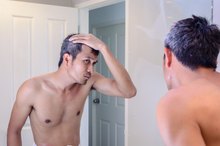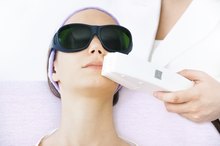Difference in Rogaine for Men & Women
Rogaine is the only topical medication approved by the Food and Drug Administration for hair regrowth. It comes in versions marketed separately to men and women, as well as an extra-strength version. The only difference between the basic men's and women's formulations is in their packaging, but the extra-strength version has more of the active ingredient and is FDA-approved for use by men only.
History
The active ingredient in Rogaine, minoxidil, was originally developed as an oral medication to treat high blood pressure, but a side effect appeared during human testing: Test subjects were reporting new body hair growth. Further research led to the introduction in 1988 of Rogaine as a prescription treatment for men with pattern baldness. In 1992, the FDA approved Rogaine for use by women with a prescription. Both versions became available without a prescription in 1996. The men's extra-strength version went on sale in 1997, also without a prescription.
- The active ingredient in Rogaine, minoxidil, was originally developed as an oral medication to treat high blood pressure, but a side effect appeared during human testing: Test subjects were reporting new body hair growth.
- Further research led to the introduction in 1988 of Rogaine as a prescription treatment for men with pattern baldness.
Composition
The Best Hair-Loss Products for Women
Learn More
The basic products, now called Men's Rogaine and Women's Rogaine, have an identical formulation: 2 percent minoxidil in a solution of 60 percent alcohol, 20 percent propylene glycol and 18 percent water. The extra-strength version is a foam made up of 5 percent minoxidil with 30 percent alcohol, 50 percent propylene glycol and 15 percent water. All versions are topical, meaning they are applied directly to the scalp, not taken internally.
Effects
According to the Bernstein Medical Center for Hair Restoration in New York, tests have found women to be more susceptible to certain side effects of minoxidil, most notably lowered blood pressure, lightheadedness and allergic skin reactions 1. That's why only the 2 percent concentration is approved for use by women. In addition, the medication can lead to facial hair growth, especially if the medicine runs down the temples or forehead after being applied. This occurs more often with the 5 percent formulation, another reason why women are discouraged from using it. Nevertheless, according to the American Hair Loss Institute, many dermatologists put female patients on the 5 percent version. Such "off-label" use is not illegal; the FDA's men-only approval for extra-strength minoxidil means only that the manufacturer cannot market it to women.
- According to the Bernstein Medical Center for Hair Restoration in New York, tests have found women to be more susceptible to certain side effects of minoxidil, most notably lowered blood pressure, lightheadedness and allergic skin reactions 1.
- In addition, the medication can lead to facial hair growth, especially if the medicine runs down the temples or forehead after being applied.
Effectiveness
The Effects of Woman Using Rogaine for Men
Learn More
The American Hair Loss Institute says minoxidil actually might work better for women than men 45. It recommends that men first try finasteride, an oral medication sold under the brand name Propecia, before trying Rogaine to treat pattern baldness. Propecia has not been approved for women. The institute suggests women see a doctor who specializes in hair loss before starting minoxidil treatment 4.
Considerations
According to the National Library of Medicine, minoxidil is most effective for people under age 40 with pattern baldness whose hair loss is relatively recent and ongoing 2. It won't help people who have gone completely bald, and it's not effective for people with receding hairlines. The library says that users typically have to use the medicine for four months to a year before seeing any effect, and that the new hair tends to fall out within months of quitting minoxidil treatment 2.
Related Articles
References
- Bernstein Medical Center: Minoxidil
- National Library of Medicine: Topical Minoxidil
- American Hair Loss Association: Women's Treatment
- American Hair Loss Association: Men's Treatment
- Pharmacia & Upjohn Company. Loniten minoxidil tablets, USP. Updated January 2015.
- No author listed. Topical minoxidil approved by FDA. Clin Pharm. 1988;7(12):858,862.
- Center for Drug Evaluation and Research. Application number: NDA 20-834. October 1, 1997.
- Ustuner ET. Cause of androgenic alopecia: crux of the matter. Plast Reconstr Surg Glob Open. 2013;1(7):e64. doi:10.1097/GOX.0000000000000005
- Suchonwanit P, Thammarucha S, Leerunyakul K. Minoxidil and its use in hair disorders: A review. Drug Des Devel Ther. 2019;13: 2777-86. doi:10.2147/DDDT.S214907
- Johnson & Johnson. Product monograph: Rogaine topicsal 2% solution: Minoxidil topical solution 20 mg/mL (2% w/v), Rogaine foam 5%: Minoxidil foam 50 mg/g (5% w/w), Women’s Rogaine foam 5%: Minoxidil Foam 50 mg/g (5%w/w). Updated July 20, 2014.
- Darwin E, Hirt PA, Fertig R, Doliner B, Delcanto G, Jimenez JJ. Alopecia areata: Review of epidemiology, clinical features, pathogenesis, and new treatment options. Int J Trichology. 2018;10(2):51-60. doi:10.4103/ijt.ijt_99_17
- Braam B, Taler SJ, Rahman M, et al. Recognition and management of resistant hypertension. Clin J Am Soc Nephrol. 2017;12(3):524-35. doi:10.2215/CJN.06180616
- Slove S, Lannoy M, Behmoaras J, et al. Potassium channel openers increase aortic elastic fiber formation and reverse the genetically determined elastin deficit in the BN rat. Hypertension. 2013;62(4):794-801. doi:10.1161/HYPERTENSIONAHA.113.01379
- Jimenez-Cauhe J, Saceda-Corralo D, Rodrigues-Barata R, et al. Effectiveness and safety of low-dose oral minoxidil in male androgenetic alopecia. J Am Acad Dermatol. 2019;81(2):648-9. doi:10.1016/j.jaad.2019.04.054
- Shah NH, Ruan DT. Pheochromocytoma: a devious opponent in a game of hide-and-seek. Circulation. 2014;130(15):1295-8. doi:10.1161/CIRCULATIONAHA.114.008544
- Rossi A, D'arino A, Pigliacelli F, et al. The diagnosis of androgenetic alopecia in children: Considerations of pathophysiological plausibility. Australas J Dermatol. 2019;60(4):e279-e283. doi:10.1111/ajd.13079
- Mundt HM, Matenaer M, Lammert A, et al. Minoxidil for treatment of resistant hypertension in chronic kidney disease--A retrospective cohort analysis. J Clin Hypertens (Greenwich). 2016;18(11):1162-7. doi:10.1111/jch.12847
Writer Bio
Cam Merritt is a writer and editor specializing in business, personal finance and home design. He has contributed to USA Today, The Des Moines Register and Better Homes and Gardens"publications. Merritt has a journalism degree from Drake University and is pursuing an MBA from the University of Iowa.









